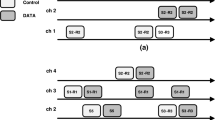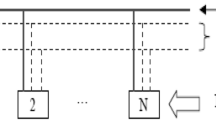Abstract
In a regular wireless ad hoc network, the Medium Access Control (MAC) protocol coordinates channel access among nodes, and the throughput of the network is limited by the bandwidth of a single channel. The multi-channel MAC protocols can exploit multiple channels to achieve high network throughput by enabling more concurrent transmissions. In this paper, we propose a hybrid and adaptive protocol, called H-MMAC, which utilizes multi-channel resources more efficiently than other multi-channel MAC protocols. The main idea is to adopt the IEEE 802.11 Power Saving Mechanism and to allow nodes to transmit data packets while other nodes try to negotiate the data channel during the Ad hoc Traffic Indication Message window based on the network traffic load. The analytical and simulation results show that the proposed H-MMAC protocol improves the network performance significantly in terms of the aggregate throughput, average delay, fairness and energy efficiency.














Similar content being viewed by others
References
IEEE 802.11 Working Group. (1997). Wireless LAN medium access control (MAC) and physical layer (PHY) specification.
Mo, J., So, H.-S. W., & Walrand, J. (2008). Comparison of multichannel MAC protocols. IEEE Transactions on Mobile Computing, 7(1), 50–65.
Wu, S.-L., Lin, C.-Y., Tseng, Y.-C., & Sheu, J.-L. (2000). A new multi-channel MAC protocol with on-demand channel assignment for multi-hop mobile ad hoc networks. In Proceedings of international symposium on parallel architectures, algorithms and networks, 2000, I-SPAN, 2000.
Lei, H., Ren, Z., Gao, C., & Guo, Y. (2012). A new multi-channel MAC protocol for 802.11-based wireless mesh networks. In International conference on computer science and electronics engineering (ICCSEE).
Tseng, Y.-C., Wu, S.-L., Lin, C.-Y., & Sheu, J.-P. (2001). A multi-channel MAC protocol with power control for multi-hop mobile ad hoc networks. In International conference on distributed computing systems workshop (pp. 419–424).
Shi, J., Salonidis, T., & Knightly, E. (2006). Starvation mitigation through multi-channel coordination in CSMA multi-hop wireless networks. In Proceedings of ACM MobiHoc.
Almotairi, K. H., & Shen, X. (2010). Symmetrical power control for multi-channel multi-hop wireless networks. In Proceedings of IEEE conference on global telecommunications GLOBECOM’10.
Sarkar, M., Nagaraj, S., & Balsania, I. H. (2011). A SINR based MAC layer protocol for multi-channel ad-hoc networks. International conference on wireless communications and mobile computing (IWCMC).
Almotairi, K. H., & Shen, X. (2010). MMAC-HR: Multi-channel medium access control with hopping reservation for multi-hop wireless. In Proceedings of IEEE conference on global telecommunications GLOBECOM’10.
Nguyen, D., Garcia-Luna-Aceves, J. J., & Obraczka, K. (2009). Collision-free asynchronous multi-channel access in ad hoc networks. In Proceedings of IEEE conference on global telecommunications GLOBECOM’09.
So, J., & Vaidya, N. H. (2004). Multi-channel MAC for ad hoc networks: Handling multi-channel hidden terminals using a single transceiver. In Proceedings of the 5th ACM international symposium on mobile ad hoc networking and computing (Mobihoc’04).
Dang, D. N. M., Van Nguyen, M., Hong, C. S., Lee, S., & Chung, K. (2012). An energy efficient multi-channel MAC protocol for wireless ad hoc networks. In IEEE global communications conference (GLOBECOM) (pp. 433–438), 3–7 Dec. 2012.
Chen, W.-T., Liu, J.-C., Huang, T.-K., & Chang, Y.-C. (2008). TAMMAC: An adaptive multi-channel MAC protocol for MANETs. IEEE Transactions on Wireless Communications, 7(11), 4541–4545.
Zhang, J., Zhou, G., Huang, C., Son, S. H., & Stankovic, J. A. (2007). TMMAC: An energy efficient multi-channel MAC protocol for ad hoc networks. In IEEE international conference on communications (ICC ’07) (pp. 3554–3561), 24–28 June 2007.
Chang, C.-Y., Chang, C.-Y., Lu, Y.-J., & Own, C.-M. (2012). ECU-MAC: A multi-channel MAC protocol for enhancing channel utilization in wireless networks. In 2012 fourth international conference on ubiquitous and future networks (ICUFN) (pp. 52–57), 4–6 July 2012.
Liao, W.-H., Shih, K.-P., & Chung, W.-C. (2009). Multi-channel medium access control protocol with channel distribution for mobile ad hoc networks. IET Communications, 3(12), 1821–1831.
Dang, D. N. M., & Hong, C. S. (2012). H-MMAC: A hybrid multi-channel MAC protocol for wireless ad hoc networks. In ICC’12 WS—SaCoNet-III, Canada.
Shin, K.-S., Yun, S.-Y., & Cho, D.-H. (2011). Multi-channel MAC protocol for QoS support in ad-hoc network. In Proceedings of IEEE consumer communications and networking conference (CCNC).
Lo, S.-C., & Tseng, C.-W. (2007). A novel multi-channel MAC protocol for wireless ad hoc networks. In Vehicular technology conference (VTC 2007—Spring).
Won, M., Yang, C., Zhou, W., & Stoleru, R. (2013). Energy efficient multi-channel media access control for dense wireless ad hoc and sensor networks. Wireless Networks, 19(7), 1537–1551.
Tzamaloukas, A., & Garcia-Luna-Aceves, J. J. (2000). Channel-hopping multiple access. In IEEE International conference on communications (ICC 2000).
Shih, K.-P., Chen, Y.-D. & Liu, S.-S. (2010). A collision avoidance multi-channel MAC protocol with physical carrier sensing for mobile ad hoc networks. In IEEE 24th international conference on advanced information networking and applications workshops (WAINA).
Bahl, P., Chandra, R., & Dunagan, J. (2004). SSCH: Slotted seeded channel hopping for capacity improvement in IEEE 802.11 ad-hoc wireless networks. In Proceedings of the 10th annual international conference on mobile computing and networking, (MobiCom ’04).
So, H.-S.W., & Walrand, J. (2007). McMAC: A multi-channel MAC proposal for ad-hoc wireless networks. In Proceedings of IEEE WCNC 2007, Hongkong.
Almotairi, K. H. & Xuemin S. (2011). Fast and slow hopping MAC protocol for single-hop ad hoc wireless networks. In 2011 IEEE international conference on communications (ICC 2011).
Zhou, D., & Lai, T.-H. (2007). An accurate and scalable clock synchronization protocol for IEEE 802.11-based multihop ad hoc networks. IEEE Transactions on Parallel and Distributed Systems, 18(12), 1797–1808.
Rentel, C. H., & Kunz, T. (2008). A mutual network synchronization method for wireless ad hoc and sensor networks. IEEE Transactions on Mobile Computing, 7(5), 633–646.
Qi, L., & Chen, W. (2011). A clock synchronization method for ad hoc networks. In 2nd international conference on artificial intelligence, management science and electronic commerce (AIMSEC) (pp. 3614–3617), 8–10 Aug. 2011.
Bianchi, G. (2000). Performance analysis of IEEE 802.11 distributed coordination function. IEEE Journal of Selected Areas in Communication, 18, 535.
Ergen, M., & Varaiya, P. (2005). Throughput analysis and admission control in IEEE 802.11a. Mobile Networks and Applications, 10, 705.
Wang, Q., Leng, S., & Zhang, Y. (2012). An IEEE 802.11p-based multichannel MAC scheme with channel coordination for vehicular ad hoc networks. IEEE Transactions on Intelligent Transportation Systems, 13(2), 449–458.
Jain, R., Chiu, D.-M. & Hawe, W. (1984). A quantitative measure of fairness and discrimination for resource allocation in shared computer systems. Technical Report TR-301, DEC Research Report.
Hua, C., & Zheng, R. (2008). Starvation modeling and identification in dense 802.11 wireless community networks. In IEEE INFOCOM 2008, pp. 1022–1030, 13–18 April 2008.
Acknowledgments
This research was supported by the MSIP (Ministry of Science, ICT & Future Planning), Korea, under the ITRC (Information Technology Research Center) support program (NIPA-2013-H0301-13-4006) supervised by the NIPA (National IT Industry Promotion Agency).
Author information
Authors and Affiliations
Corresponding author
Rights and permissions
About this article
Cite this article
Dang, D.N.M., Hong, C.S. & Lee, S. A hybrid multi-channel MAC protocol for wireless ad hoc networks. Wireless Netw 21, 387–404 (2015). https://doi.org/10.1007/s11276-014-0789-8
Published:
Issue Date:
DOI: https://doi.org/10.1007/s11276-014-0789-8




